Eleven Most Endangered Places, 2009
Each year, Landmarks Association publishes a list of the eleven places deemed most threatened with demolition. This year's list departs from past convention by introducing new buildings facing more immediate threat and placing others on a watch list. Landmarks introduced this list at the ceremony for the Most Enhanced Places on May 15, 2009 during Preservation Week.
Stone House, 124 East Steins Street
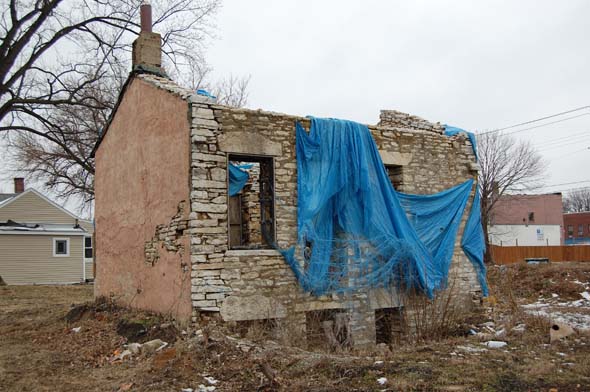
While the exact date of this single-room stone house is unknown (it probably dates to the early 19th century), the house type and dry-laid rough-cut stone construction make this a singular work of vernacular architecture. The house lost all of its timber elements years ago, and has sat as a forlorn shell for a long time. The soft, dry mortar of the stone walls won't survive continual exposure, and the present owner now contemplates demolition.
William Drosten House, 3330 Missouri Avenue
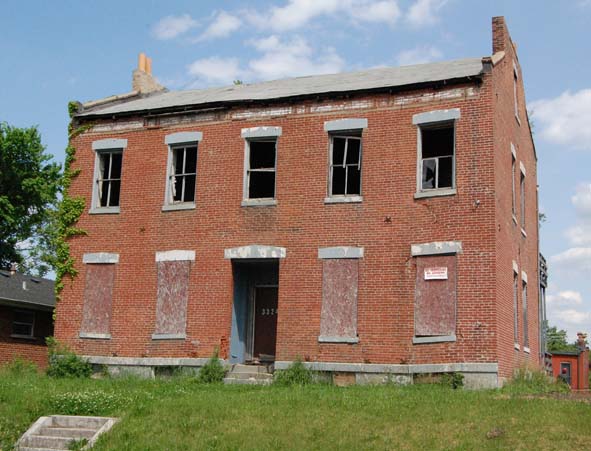
Owned by the Land Reutilization Authority, the house built by merchant William Drosten pre-dates much of the surrounding Benton Park built environment. Unfortunately, the house has sat vacant for years, with resulting deterioration and a sinking corner. The large size of the center-hall house makes it a difficult property to rehabilitate. Hopefully, a creative developer will discover this dusty, promising gem.
Mann Elementary School, 4047 Juniata Avenue
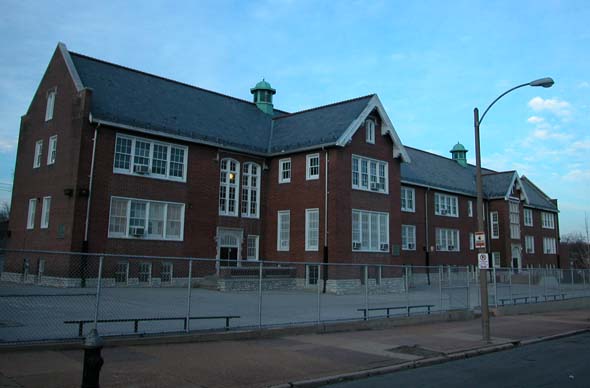
While it may be unfathomable that a William B. Ittner-designed school is threatened with demolition by the St. Louis Public School district itself, that is the case with Mann School, built in 1901 and 1916. At a March 12 meeting of the Special Administrative Board, Superintendent Kelvin Adams stated that Mann School may be demolished and replacement with a new school building. The district will not take the demolition off of the table, and is seeking a bond issue next year for new school construction.
James Clemens, Jr. House, 1849 Cass Avenue
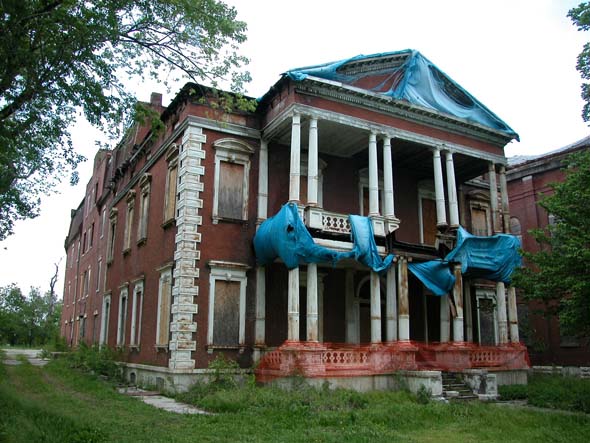
Last year during Preservation Week, a portion of the chapel wall and roof collapsed in a storm. The formidable structure has not suffered further damage, but a large hole in the roof of the mansion itself worsens daily. McEagle Properties owns the house and has offered promises of repair with no follow-through -- as the developer asks for large city subsidy, the time is right for the city to make saving the Clemens House a baseline condition of any redevelopment plan.
Falstaff Brewery Buildings, 2313 Lemp Avenue
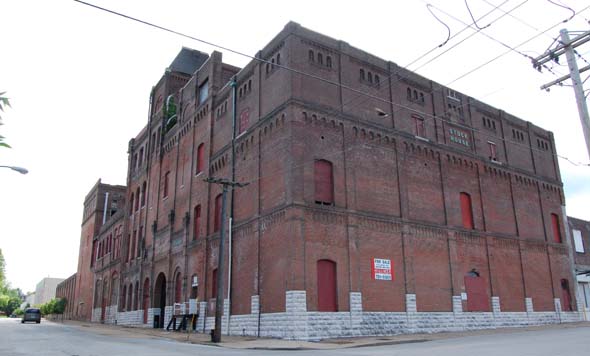
There now is a for sale sign on the old Consumer's Brewery in Benton Park; hopefully, a sale to a rehab-minded party will soon follow. The 1930s additions are being used, but the most historic portion is abandoned. The condition of the earliest buildings of the complex is poor, and a small fire in 2006 raised preservationist concerns. Neighborhood residents complain that the historic buildings are frequently unsecured.
Fourth Baptist Church, 2903 N. 14th Street
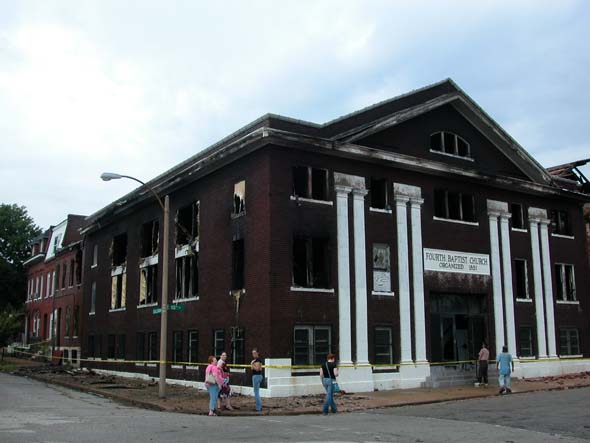
On September 20, 2008, a devastating fire struck the Fourth Baptist Church in Old North. The church buildings already had been vacated after the small, cash-strapped congregation could not afford to fix a boiler failure in 2002. The fire left the church annex with a gaping hole in its front wall and the lovely sanctuary severely damaged. The sanctuary is definitely salvageable, but the congregation lacks the means to undertake necessary stabilization.
McEagle Holdings Across North St. Louis
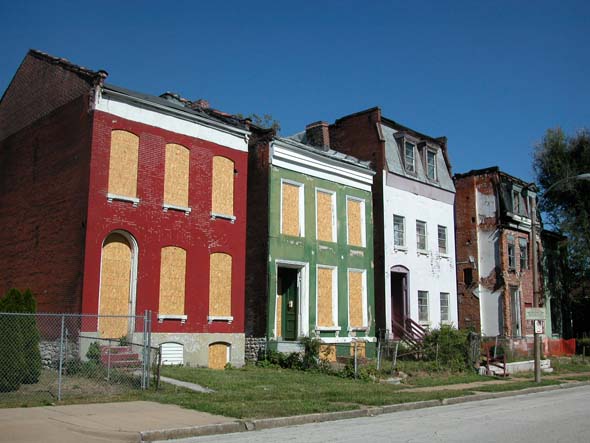
On May 21, McEagle Properties made a public announcement on its plans for a mixed-use development in north St. Louis. What will be the fate of the over 200 historic buildings that McEagle owns in Old North St. Louis, St. Louis Place and JeffVanderLou? That's an open question. We hope that no matter what is included in the project plan, McEagle immediately stabilizes and secures its historic buildings.
Murphy Building (East St. Louis), 230 Collinsville Avenue
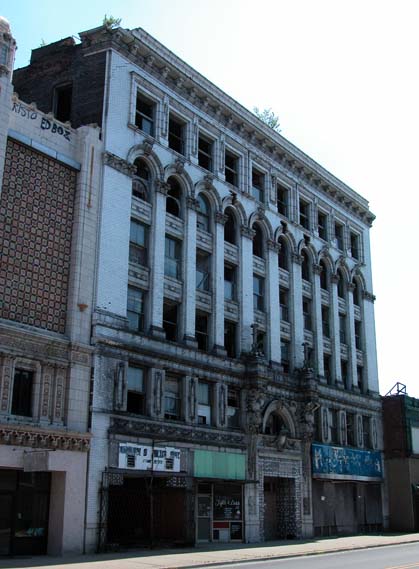
Our first-ever East St. Louis listing is one of that city's most graceful landmarks. The Murphy Building's amazing front elevation of bakery brick and terra cotta anchors the business district on Collinsville Avenue, but the city of East St. Louis recently has taken aim at the vacant office building and others. Just a half-block from a MetroLink station, the Murphy Building should be an important part of a reborn East St. Louis.
DeVille Motor Hotel, 4483 Lindell Boulevard (Under Demolition, July 2009)
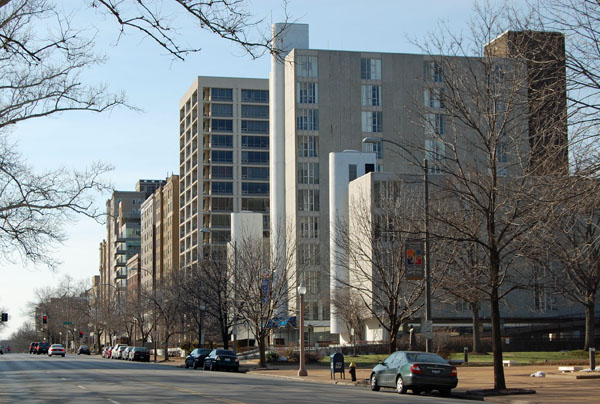
This became the final year for the DeVille Motor Hotel, recently named the San Luis Apartments. With a new Archbishop in place, the Archdiocese moved forward with a plan to demolish the retro jewel to make way for a surface parking lot. Lost was a stylish, idiosyncratic work of modern architecture eligible for the National Register of Historic Places and designed by New Orleans' Charles Colbert and built in 1963.
St. Mary's Infirmary, 1528 Papin Avenue
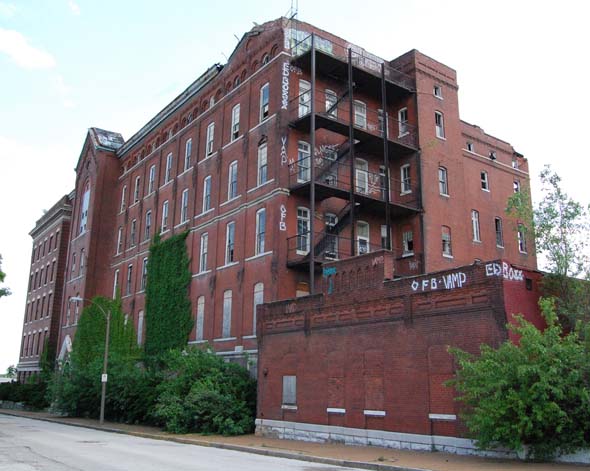
The condition of St. Mary's Infirmary is frightening -- anyone who has seen the side facing Chouteau Avenue lately has seen the ongoing collapse of the rear wall. Purchased for condominium conversion at the market peak in 2005, the old hospital's fate is now uncertain. The masonry expression of the main building -- built in 1887-1896 and design by Aloysius Gillick -- is among the city's most unique, and worth protection.
Avalon Theater, 4225 S. Kingshighway
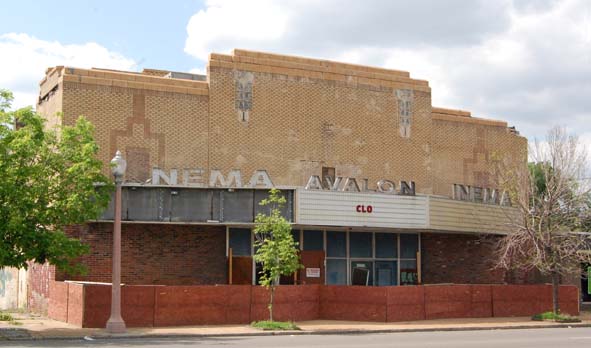
The Avalon's condition has become dire in the years since its dollar-house days ended in 1999. The Avalon is one of a few remaining neighborhood movie theaters, and one of the last from the Depression era -- its significance has grown with the loss of many other. The Avalon's owner has not made repairs or serious efforts to sell it, and threats by the alderman to take the building through eminent domain have not changed owner inaction.
Watch List
This year we are also creating our first-ever watch list of buildings that face no imminent threat of demolition, but whose futures are still gravely in doubt. Those buildings are:
- Mullanphy Tenement at 2118 Mullanphy Street in St. Louis Place
- Carr School at 1421 Carr Street in Carr Square
- Bethlehem Lutheran Church at 2153 Salisbury Avenue in Hyde Park
- Andrew & Laura Scott Einstmann House at 2347 Virginia Avenue in Tower Grove East
- Commercial Building at 5286 Page Boulevard in the Academy neighborhood (demolished June 2009)
- Sun Theater at 3627 Grandel Square in Grand Center
- Shriners' Hospital and Central Institute for the Deaf on Euclid Avenue in the Central West End
- Wellston Station at 6111 Dr. Martin Luther King Drive in Wells-Goodfellow
Creation of the watch list allows us to extend the warning that the endangered list sounds. While neither list is inclusive of all buildings in our region that face the threat of disappearing from existence, they are as comprehensive as possible and illustrate the range of potential negligence in our region's stewardship of its built heritage.
